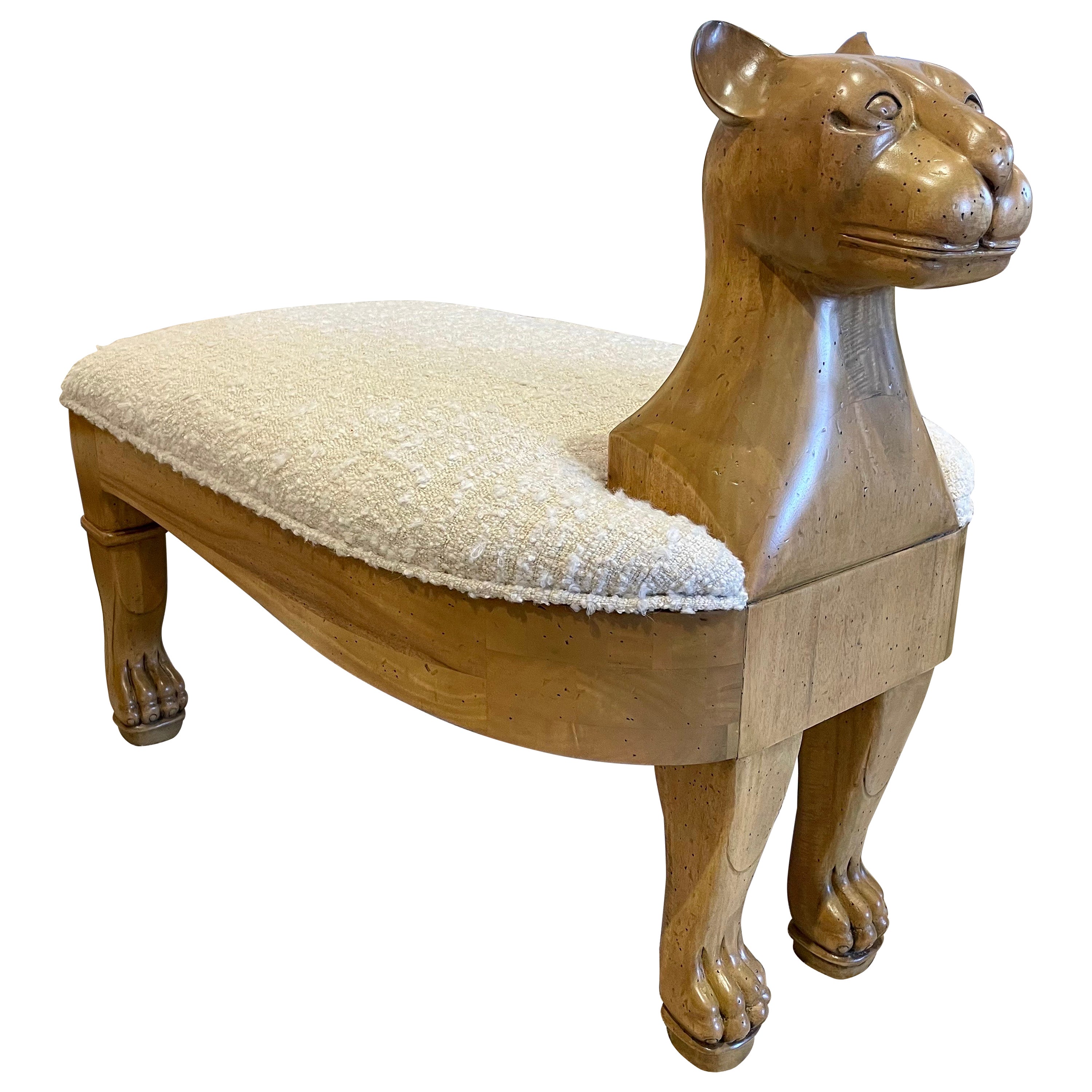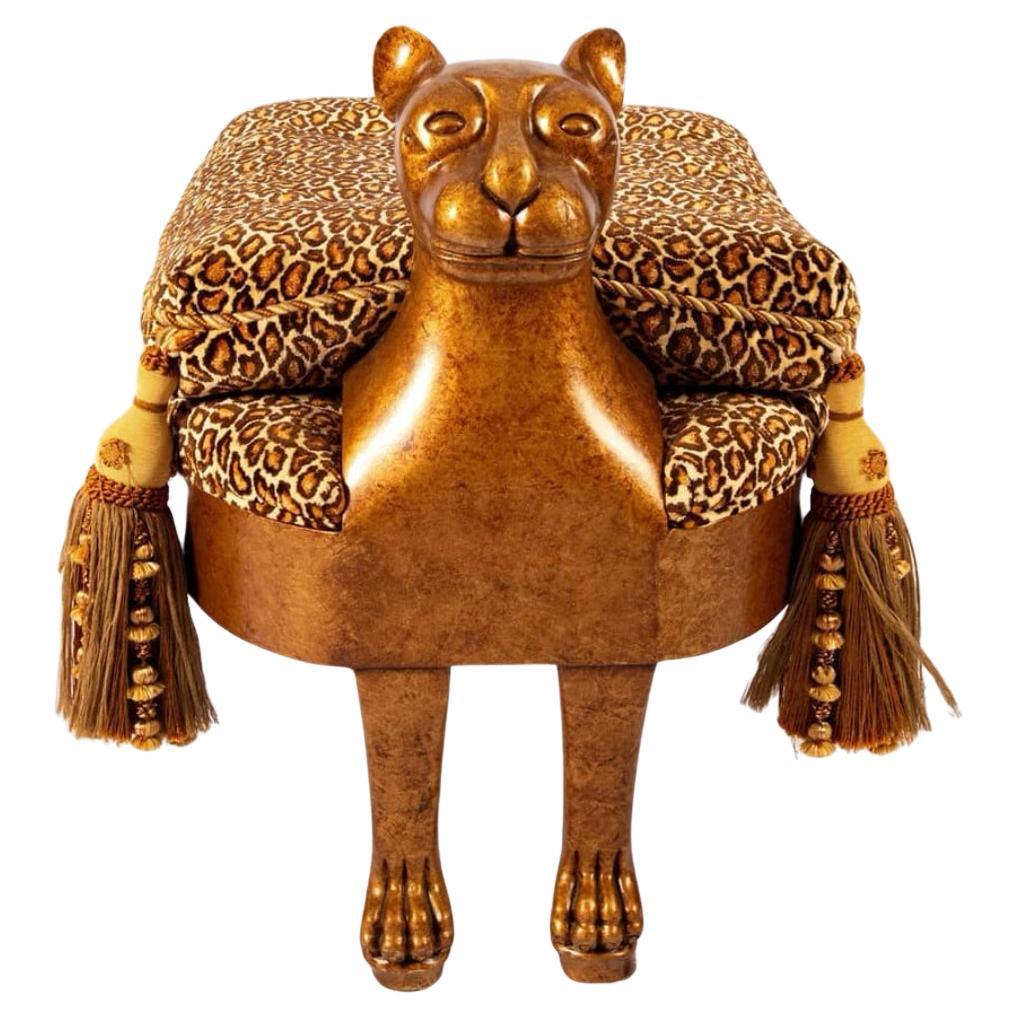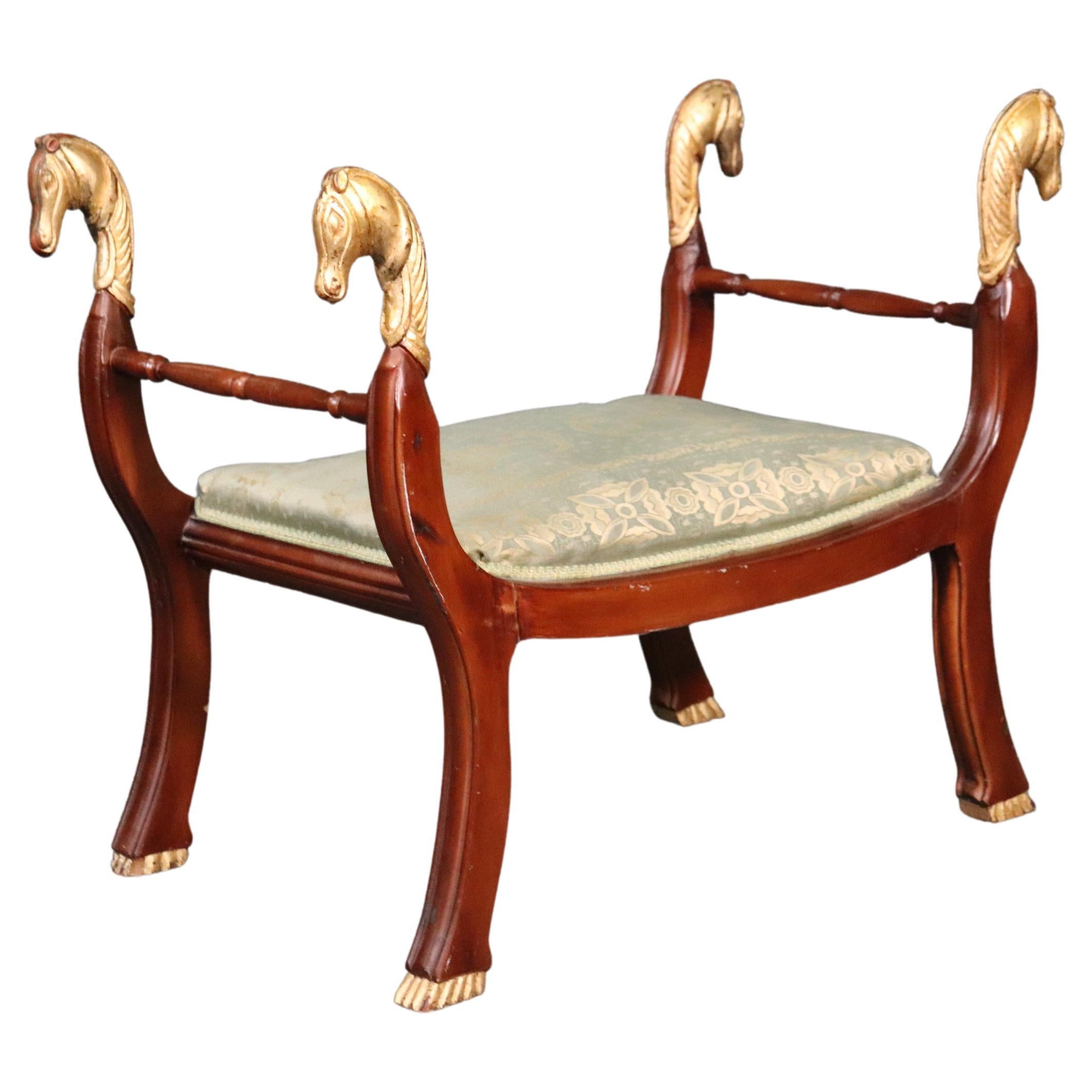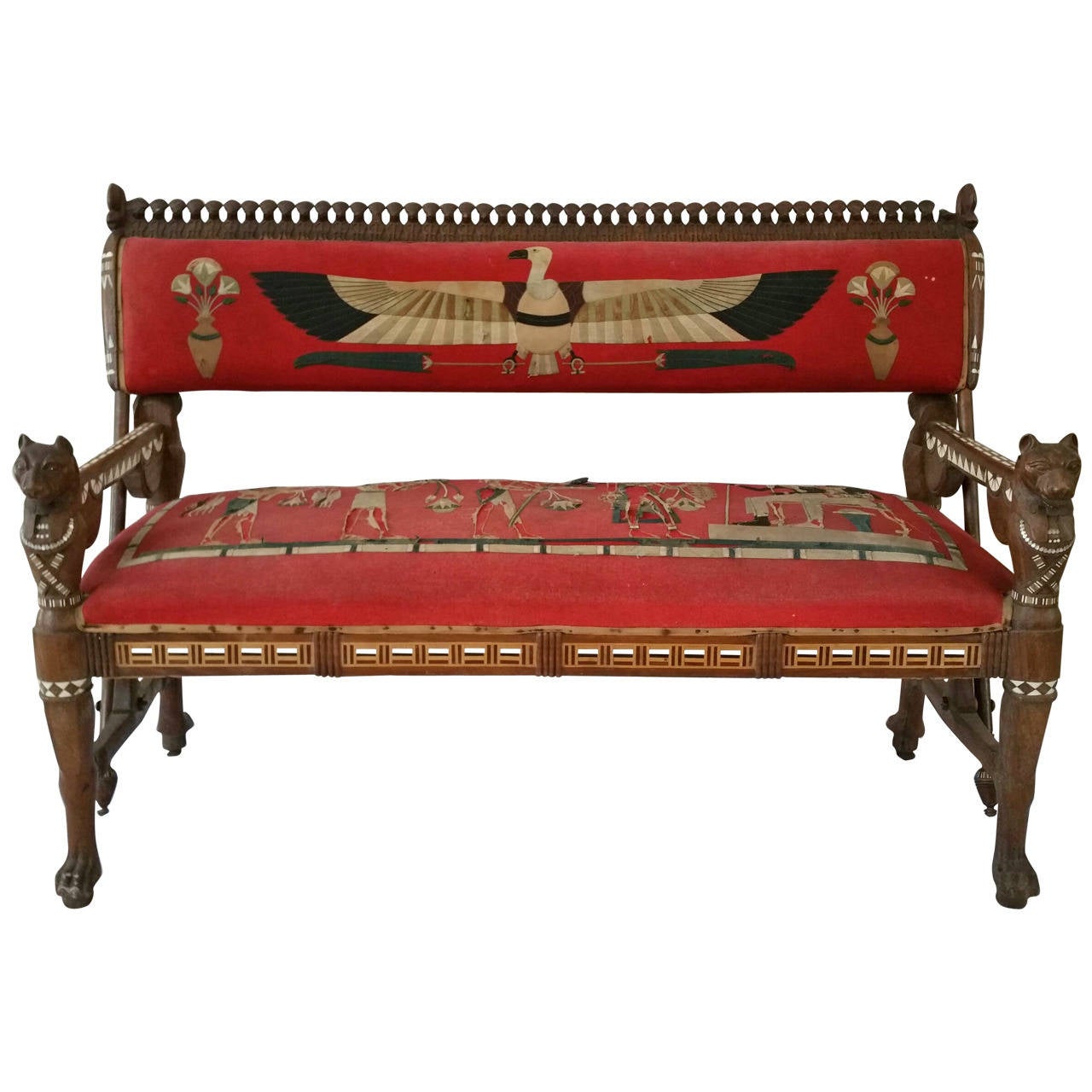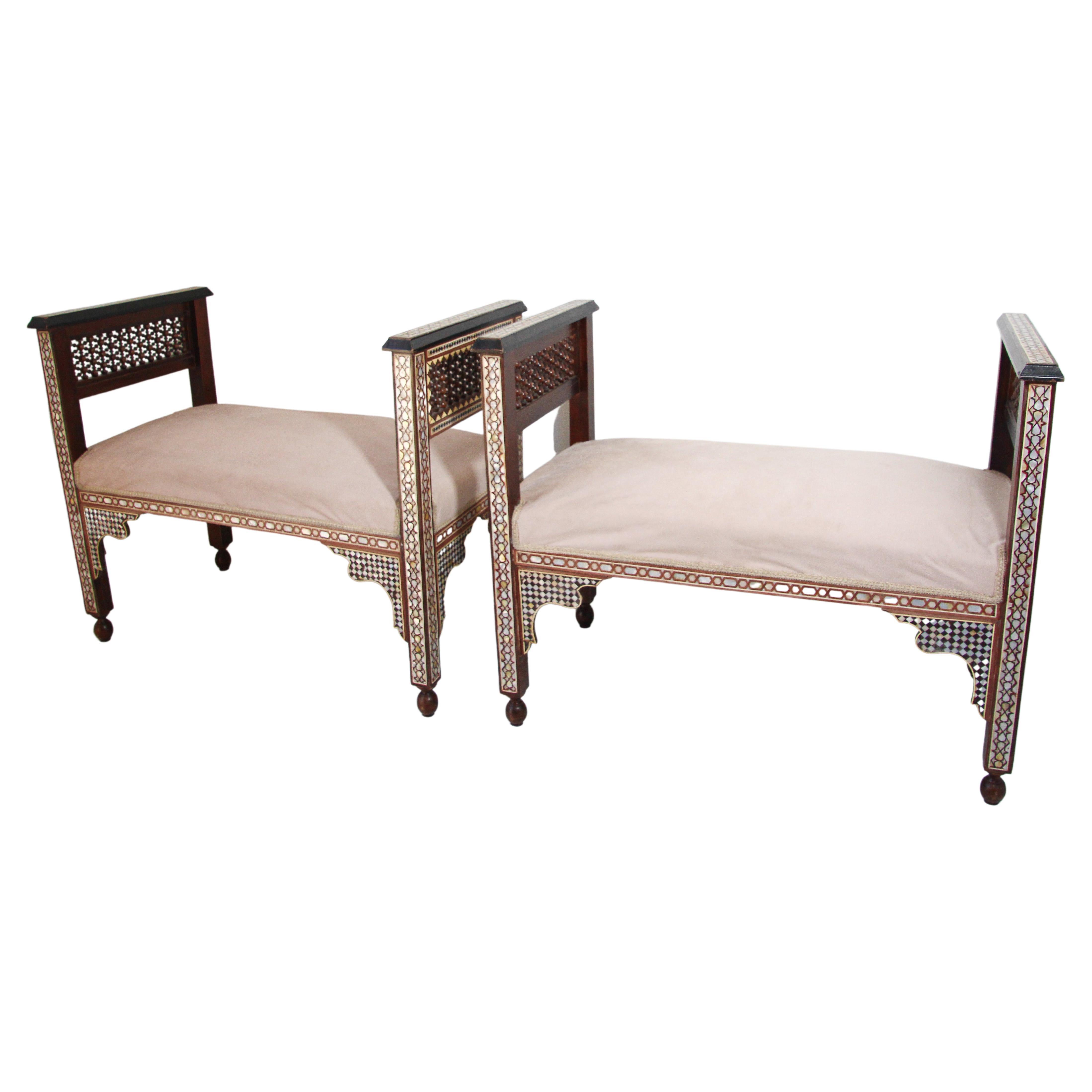Items Similar to An Extremely Rare Exhibition Quality Egyptian Revival Walnut and Inlaid Bench
Want more images or videos?
Request additional images or videos from the seller
1 of 10
An Extremely Rare Exhibition Quality Egyptian Revival Walnut and Inlaid Bench
About the Item
An Extremely Rare and Possibly Unique Walnut and Inlaid Egyptian Revival Bench or Window Seat
French Circa - 1922-25
Of exhibition quality, made from solid walnut and profusely inlaid with geometric tesserae including bone and ivory, along with ebony, purplewood and fruitwood. One end comprising of dual monopodiae supports with carved mythical animal masks and a dividing pierced splat, the rectangular framed woven seat with dual raised tails to the opposing short side that are joined at their ends above the long rear side, the conforming legs with carved human feet.
The stylised heads do not seem to resemble any one particular animal or Egyptian god-they have elements that might suggest they are panthers, others that suggest the dog god Anubis, and in all likelihood they were simply meant to have been seen as fantastical representations of mythical beings.
The heads are yoked together with something approaching a more conventional chair splat with the heads, rails, tails and splat are all inlaid with a combination of exotic woods including ebony, purpleheart and fruitwoods as well as ivory and bone in the ancient Egyptian taste. This sort of profuse inlay is common on the best Art Deco furniture but, of course, the use of Egyptian motifs is much more unusual.
A date of c.1922 is highly likely to be accurate as it was in this year that a craze for Egyptomania seized the world due to the discovery of Tutankhamun's tomb by Harold Carter and his team in the Valley of the Kings. We have included an image of the antechamber in the tomb showing furniture stacked up in piles and it is possible to see part of two of the benches of related form which must have inspired the present piece. The furniture in the tomb was gilded and/or painted and not inlaid so the maker of our piece clearly decided to take the most time-consuming route possible when producing this bench and no expense was spared. Whereas items such as Egyptian revival jewels by Cartier and the like survive in reasonable numbers, pieces of furniture in this taste are extremely rare.
The delicacy of the work and the design of this extraordinary piece of furniture suggests that it was probably made by a leading French workshop of the period. Related articles have been sold a few times over the years but none have quite the delicacy of the present piece and the particularly refined inlay work on a walnut base, most of these pieces utilising woods such as cedar instead.
A pair of stools in the form of lions which bear comparison with the present piece are illustrated in B.M. Newman, Fantasy Furniture, 1989, New York, p. 34.
Ever since the first European explorers visited Egypt the country and its iconography have been a source of great interest to European connoisseurs and those who execute designs for the decorative arts. Vivant Denon's evocative drawings of Egypt and its antiquities, produced whilst on campaign with Napoleon in 1798-1801 caused a sensation and inspired the work of designers in England such as Thomas Hope and George Smith and the construction of buildings such as William Bullock's Egyptian Museum in London. However when tombs in Egypt began to be systematically excavated in the 20th century and some of the incredible treasures they contained were photographed and shown in newspapers worldwide a whole new mania was created. The discovery of Tutankhamun's tomb and its largely untouched contents in remarkable condition gripped the world and visits to see the treasures in Cairo or on one of their increasingly rare international exhibition tours are the only ways that most people today can experience these incredible objects. This bench is a rare example of a furniture maker bringing the past up to date fusing the latest styles and techniques with a truly ancient taste making this bench is a real conversation piece.
The item within this lot containing ivory has been registered in accordance with the Ivory Act (Section 10). Ref GJU8Q83
Width: 41 1/4 inches - 105cm
Height: 36 1/2 inches - 92cm
Depth: 21 1/2 inches - 55cm
- Dimensions:Height: 36.5 in (92.71 cm)Width: 41.25 in (104.78 cm)Depth: 21.5 in (54.61 cm)
- Style:Egyptian Revival (Of the Period)
- Materials and Techniques:
- Place of Origin:
- Period:
- Date of Manufacture:Circa - 1922-25
- Condition:Wear consistent with age and use.
- Seller Location:Benington, GB
- Reference Number:
About the Seller
5.0
Gold Seller
These expertly vetted sellers are highly rated and consistently exceed customer expectations.
Established in 1969
1stDibs seller since 2015
112 sales on 1stDibs
Typical response time: <1 hour
Associations
LAPADA - The Association of Arts & Antiques DealersThe British Antique Dealers' Association
- ShippingRetrieving quote...Ships From: Benington, United Kingdom
- Return PolicyA return for this item may be initiated within 3 days of delivery.
More From This SellerView All
- Exhibition Quality Italian 19th Century Carved Walnut Armchair After Andrea BLocated in Benington, HertsAn exhibition quality grand Italian walnut armchair carved in the Baroque style after Andrea Brustolon, possibly by the great Florentine carver Luigi Frullini...Category
Antique 1850s Italian Armchairs
MaterialsWalnut
- Exceptional Quality and Rare Central European Nero Portoro Serpentine MarbleLocated in Benington, HertsAn exceptional quality and rare Central European Nero Portoro serpentine marble topped gilt-wood console table of large proportions and fine original patina. Probably Austrian - c...Category
Antique Early 19th Century Austrian Console Tables
MaterialsMarble
- Extremely Rare Pair of Regency Cast-Iron Sarcophagus Shaped Strong BoxesLocated in Benington, HertsAn extremely rare pair of Regency cast-iron sarcophagus shaped strong boxes. Regency, circa 1820 Painted to simulate palisander wood and with parcel-gilt, the cavetto-moulded hinged lids cast with flower sprays above foliate-cast bands over front panels relieved with river gods within canted corners cast with standing muses, the sides with lion mask and ring handles over leafy aprons on massive lion’s paw feet; the Brahmah type lock stamped “T. Davis from London” and impressed with the Royal Crown. These extraordinary pieces are modelled on Regency wine coolers. The forms are classic Greco-Roman revival with the boat-hook handles, mythic figures and the overall sarcophagus pattern. You would struggle to find one let alone a pair. Good items for any collection. Research on going into these strong boxes but we have found possible information on the lock stamped Davis….(historyoflocks ) The relationship of King George III and George Davis of Windsor, who was locksmith in ordinary to His Majesty. Davis, in 1799, invented and patented a unique style of lock, which was also beautifully engraved with a warning not to make duplicate keys. Sensitive government secrets always demanded, then as today, locks that were state of the art. Davis locks ended up on government dispatch boxes...Category
Antique Early 19th Century English Regency Commodes and Chests of Drawers
MaterialsIron
- Regency Amboyna and Brass Inlaid Gilt Bronze Mounted Pier TableLocated in Benington, HertsAn extremely elegant, rare Regency amboyna and brass inlaid gilt bronze mounted pier table. Provenance Part of Sir William Whitfield Collection. English Regency period, Circa 1815. The raised back with open shelf, surmounted by a pierced anthemion three quarter brass gallery above a rectangular mirror plate, flanked by gilt bronze pierced foliate scrolled supports, over a finely coloured amboyna and banded top above cut brass inlaid frieze drawer decorated with anthemion and flower head motif. The dual tapering scroll supports with palmette lappet surmounts and cut brass inlay terminate on gilt bronze claw feet, flanking a later large mirror plate to the rear, raised on a inverted breakfront plinth base edged with gilt bonze beading. Formerly in the collection of Sir William Whitfield. This elegant Regency pier table is a superb example with its fine quality mounts and distinctive amboyna veneers which are rarely found on furniture of this period. The condition is excellent, having the most wonderful colour and patination to the finest cuts of amboyna that would have been available, during the early 19th century this veneer was thought to be worth more in its weight than gold. This table would have almost certainly been especially commissioned, further research maybe undertaken to find a comparative example and insight to a potential maker. As such pieces in amboyna are far rarer, an example of pier table has yet to be found, but an amboyna sofa table with extremely similar brass inlay and form can be seen in Clifford Musgrave’s book Regency Furniture, published by Faber and Faber in 1961, plate 63. It is from the Royal Collection and the caption includes ‘made about 1816 for Clarement,’ (Claremont) ‘ Esher, Surrey, home of the Princess Charlotte...Category
Antique 19th Century British Regency Vanities
MaterialsBrass, Bronze
- Rare Mid 18th Century German Walnut Pewter & Ivory Marquetry Serpentine CommodeLocated in Benington, HertsA Fine 18th Century German Walnut shaped oxbow-fronted Commode inlaid with Ivory and Pewter German - Probably made in Braunschweig Circa 1740 A masterful example of a fine 18th ce...Category
Antique 1740s German Commodes and Chests of Drawers
MaterialsIvory, Tapestry, Walnut
- Fine Regency Amboyna And Ebony Inlaid Gilt Bronze Mounted Shaped CabinetLocated in Benington, HertsOf outstanding quality, an early 19th Century Regency ormolu mounted amboyna and ebony shaped side cabinet on tapering legs English circa 1810. Finely decorated with ebony bea...Category
Antique 19th Century English Regency Cabinets
MaterialsEbony, Amboyna
You May Also Like
- Egyptian Revival Style Whimsical Wood Bench/ OttomanLocated in East Hampton, NYA whimsical Egyptian Revival style bench or ottoman with NEW boucle fabric. The wood is neutral and in wonderful condition. Solid and very comfortable for additional seating or simpl...Category
Vintage 1980s American Egyptian Revival Benches
MaterialsBouclé, Wood
- Egyptian Revival Gilt & Lacquered Nicely Carved Cat BenchLocated in Chicago, ILHand carved and gold leaf finished whimsical wooden bench carved as a majestic cat. The seat is covered in a plush leopard print button tufted upholstery, adorned with a pair of beau...Category
Vintage 1970s American Egyptian Revival Benches
MaterialsGold Leaf
- Egyptian Revival Gilded Cerule Form Gilded Horse Head Bench StoolLocated in Swedesboro, NJThis is a gorgeous stool that evokes the stage of "The Ten Commandments" where so much of the movie was filled with stylized figural gilded animals adorn...Category
Vintage 1940s European Egyptian Revival Benches
MaterialsWalnut
- Rare Egyptian Revival Carved and Inlaid Rosewood LoveseatBy Christopher DresserLocated in Buffalo, NYEgyptian Revival loveseat composed of rosewood inlaid with bone,ebony ,,Upholstered in a very rare felt hand stitched applique fabric in Egyptian motif,,original,The loveseat features reversable back...Category
Antique 1880s English Egyptian Revival Loveseats
MaterialsBone, Ebony, Fabric, Rosewood
- Rare Egyptian Revival Carved and Inlaid Rosewood LoveseatBy Christopher DresserLocated in Buffalo, NYEgyptian Revival loveseat composed of rosewood inlaid with bone,ebony ,,Upholstered in a burlap fabric in Egyptian motif,,original,The loveseat features reversable back...Category
Antique 1890s English Egyptian Revival Loveseats
MaterialsBone, Rosewood
- Antique Egyptian Benches Mosaic Inlaid, a PairLocated in North Hollywood, CAA pair of antique Middle Eastern Moorish Egyptian settees inlaid with mosaic marquetry. Mosaic inlaid Levantine Moorish benches great to use at the end of the bed or in an entryway. Elegant and stylish settees for your Moroccan Moorish decor...Category
Early 20th Century Egyptian Moorish Benches
MaterialsWood
Recently Viewed
View AllMore Ways To Browse
Animal Leg Stool
Pair Of Gilded Benches
Cartier Dual Time
Wood Dog Bench
Wood Carved Bear Bench
Wood Pierced Bench
Italian Window Benches
Iron Small Benches
Padded Bench With Back
Maison Ramsay Bench
Banquette Mounted
Window Bed
Curved Brass Bench
Dark Green Velvet Bench
Knoll Bench Red
Piano Double Bench
Pair Of Italian Bench
Tara Shaw Zebra Bench
